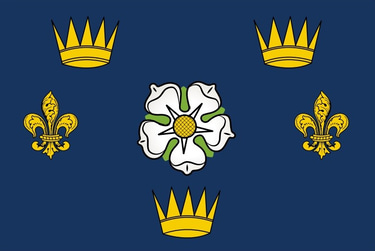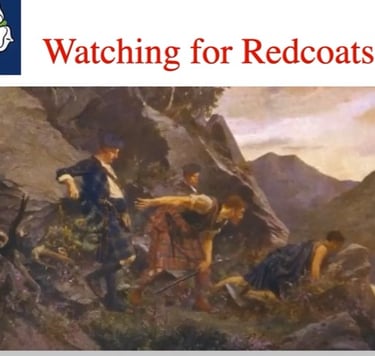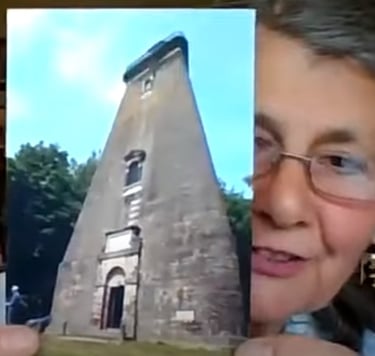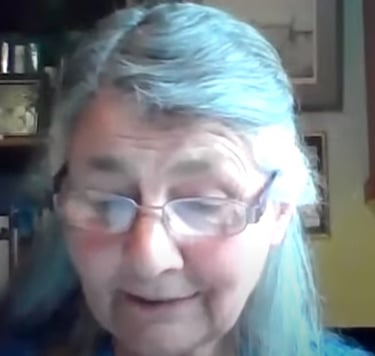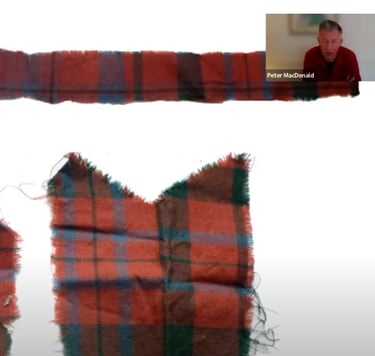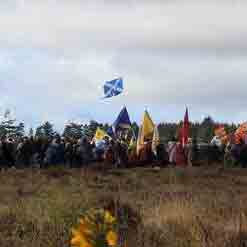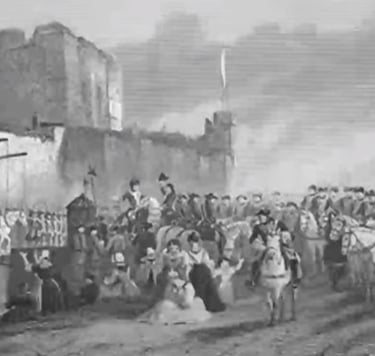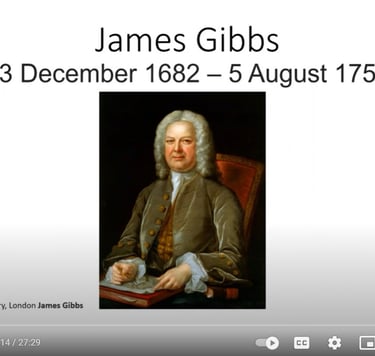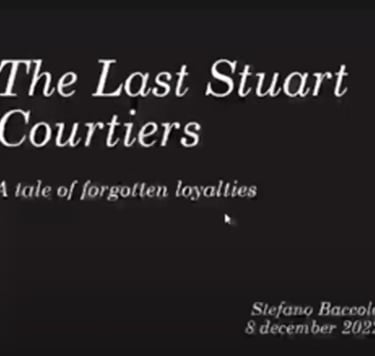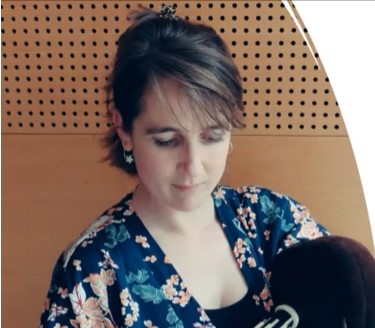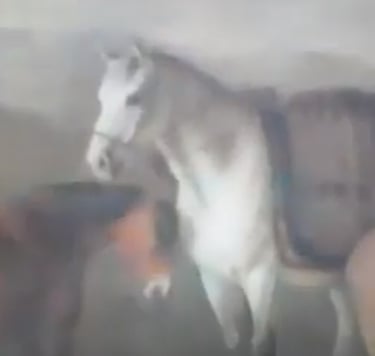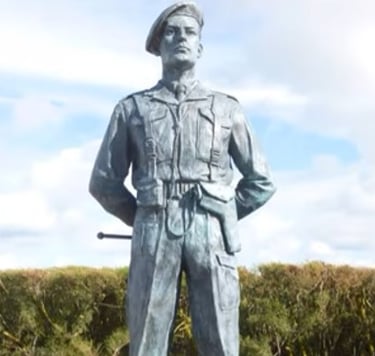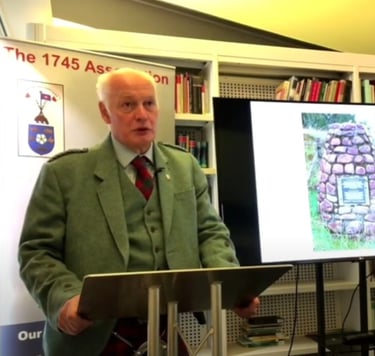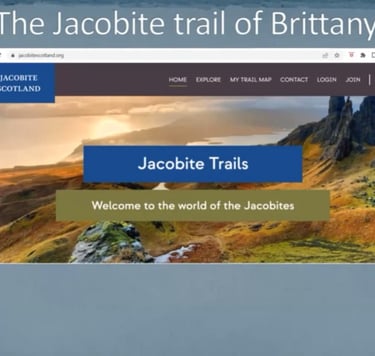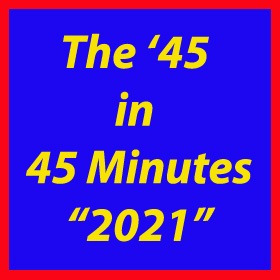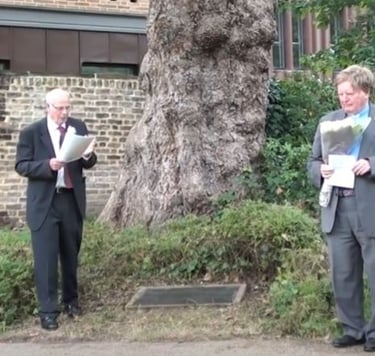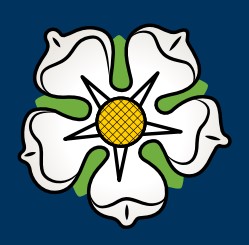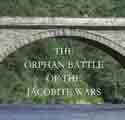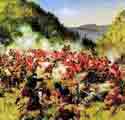Soundbites & Videos
Here you will find Audio Files and links to YouTube Videos produced by or of significant relevance to The 1745 Association.
Click on the pictures or links, where indicated, to listen of view
"The Quest for Cluny's Cage" by Glen MacDonald
In this talk, Glen MacDonald tells the story of an expedition launched by the 1745 Association in June 2017 to seek the location of Cluny's Cage on remote Ben Alder, the last hiding place of Prince Charles Edward Stuart as a fugitive in the Highlands between September 3rd and September 13th 1746 before his escape to France. Glen tells the story of how the cage was constructed by Ewan MacPherson of Cluny, considers the evidence regarding its physical layout and assesses different theories regarding its possible location. He then goes on to describe how he and Jim King identified a cave during the June 2017 expedition that appears to meet the Cage's essential criteria, being not visible from below, with an entrance concealed by two enormous boulders underneath a sheer cliff face consistent with the Cage's description by Donald MacPherson in 'The Lyon in Mourning', and offering panoramic views of Loch Ericht from which any approaching redcoats could be seen, enabling those in the Cage to make their escape before the enemy arrived. While conceding that this evidence is circumstantial rather than conclusive, Glen concludes his talk by suggesting further forensic and archaeological studies of the site could establish whether it contains any further supporting evidence that it might have been the true location of Cluny's Cage.
"A Jacobite Miscellany" by Janet Niepokojczycka
In a Jacobite Miscellany, Janet Niepokojczycka offers personal insights into six sites of Jacobite interest with which she has a personal connection, as follows: 1.Swarkestone Bridge, 2.Wentworth Woodhouse, 3.Nostell Priory, 4.Newby Hall, 5.Finsthwaite Church, 6.Chorley Hall. Janet concludes with two short poems about Culloden inspired by visits to the battlefield.
"The Horses of Culloden". Three Poems by Janet Niepokojczycka
In this short video, Janet recites three poems she composed inspired by her visits to the Culloden Battlefield and reflections on the fate of the horses deployed there. The first two,, 'For want of a nail' and 'My horse lies dead', are roundels of alternately rhyming couplets with the opening words repeated as a refrain, while the third, 'Drumossie Moor', is a shorter poem composed on the battlefield in April 2016.
“Murray of Tullibardine Tartan" Presentation by Peter MacDonald
Peter MacDonald is Scotland’s foremost tartan historian and Head of Research at the Scottish Tartans Authority. He specialises in all aspects of Tartan, with a particular interest in Jacobite era patterns and techniques through to the early commercial production of tartan by the famous weaving firm Wilsons of Bannockburn. He begins his talk on the Murray of Tullibardine Tartan by tracing its origins and its link with the Earls of Dunmore, starting with the second son of the first Marquis of Tullibardine. He then goes on to discuss how the tartan was used by 18th century artists in paintings such as that of Lord George Murray in Highland dress, and Allan Ramsay's famous portraits of Flora MacDonald, Norman MacLeod and the Earl of Loudon. He then considers examples of the tartan that can be seen today at Blair Castle, ancestral home of the Murrays of Tullibardine, and its enduring use today by family members and more widely as a fashionable and stylish tartan with links to the Jacobite Cause.
“Annual Culloden Lecture 2023" Talk by Michael Nevin
The 2023 Annual Culloden Lecture, delivered as part of the annual commemoration to mark the 277th anniversary of the last battle fought on British soil, examines cognitive biases that led to Culloden. Following a short introduction by the 1745 Association's President, the Very Rev'd Dr Emsley Nimmo, and a tribute to the Association's previous Chair, the eminent military historian Dr Christopher Duffy who passed away in November 2022, the current Chair, Michael Nevin, applies Prospect Theory to assess seven strategic decisions on the road to Culloden, as follows:
1- July 1745: Confirmation Bias and the decision to instigate the Rising,
2- August 1745: Loss Aversion, the Sunk Cost Fallacy and the decision to continue the Rising after the loss of the 'Elisabeth'.
3- October 30th 1745: Prospect Framing, the Allais Paradox and the decision to advance into England,
4- December 5th 1745: Ambiguity Aversion, the Ellsberg Paradox and the decision to retreat from Derby,
5- December 19th 1745: The Endowment Effect and the decision to leave a garrison in Carlisle,
6- February 1746: The Affect Heuristic and the retreat north after the Battle of Falkirk Muir,
7- April 1746: Optimism Bias, the Night March on Nairn and the decision to stand at Culloden.
The presentation concludes with the identification of what the speaker terms 'Bonnie Prince Charlie Syndrome' as the underlying cause of the failure of the Rising of 1745.
“The Strange Mystery of the Jacobite Graves in Cumbria" by Frank Morgan Grant
In a fascinating talk, Frank Morgan Grant reveals the results of the research he has undertaken to find out the last resting place in Carlisle, Brampton and Penrith of those Jacobites executed there in 1746. Who were they? Where and when were they executed? What was the rationale behind who was executed and why were particular places chosen for this gruesome task? Frank comments that, "Everything is not what it seems in the history books about this period of English/Scottish history, and I am hoping that at some point towards the end of the talk, we can discuss moving forward with our efforts to locate the buried bodies.” With this in mind, this presentation exceptionally includes the question and answer session after Frank's talk, in which members of his audience raise points which may help to solve this mystery and perhaps help commemorate and honour the largely forgotten Jacobite soldiers executed as traitors in Cumbria in 1746.
“A Ramble Around James Gibbs" Talk by Stephen Lord
In this presentation, Stephen Lord, Vice Chair of The 1745 Association, tells the story of the architect James Gibbs. His story is set against the background of the evolution of the British architectural style in the eighteenth century from English Baroque, associated particularly with the reign of Queen Anne, to the Palladian style associated with the Georgian era. Steve begins by placing James Gibb within the family of architects, led by Inigo Jones and including Gibbs' slightly earlier predecessors Sir Christopher Wren, Sir John Vanbrugh and Nicholas Hawksmoor, who led this movement. He then considers Gibbs' own background, development as a protegé of John Erskine, Earl of Mar, and accomplishments. These include the Senate House at Cambridge University, the Radcliffe Camera in Oxford, St Martin-in-the-Fields, Derby Cathedral and St Mary le Strand. Steve concludes his presentation by considering points of Jacobite interest in Gibbs' architectural legacy.
“The Last Stuart Courtiers" Talk by Dr Stefano Baccolo
In this presentation, Dr Stefano Baccolo describes how the putative King Charles III, more popularly known as Bonnie Prince Charlie, maintained a Royal Court in Exile throughout the period from the death of his father in 1766 to his own death in 1788. Despite his straitened circumstances, the Court was substantial, comprising some 60 courtiers, many of whom supported themselves at no charge to the man they regarded as their King. Stefano summarises the life and career of six of the leading figures at Charles's Court:
1- the Majordomos, responsible for managing household and financial affairs within the Court, Sir John Hay of Restalrig and Sir John Steuart of Ardvorlich,
2- Charles' personal secretaries, responsible for managing his diary and appointments, Andrew Lumisden of Edinburgh and Lord John Baptist Caryll,
3- his gentlemen in waiting, Henry Stafford and Henry Nairne. Henry Nairne, one of the last survivors of the Court, lived to the ripe old age of 90, returning to Scotland where he died in 1812. He was the uncle of Carolina Oliphant, Lady Nairne, and some of the accounts that Henry Nairne gave to her of the Rising and the character of Charles may have helped inspire her to compose the Jacobite songs still popular today.
“Prince Charles and the Musette" by Dr Amanda Babington
In a fascinating piece of historical detection, Amanda tells the story of the Musette, an inquiry stimulated by the rather worn-looking Musette in the West Highlands Museum to which is attached a plaque that reads ‘Charles Edward Stuart, last PRINCE of the Royal House of Stuart’. Today, the Musette is a little-known instrument with some similarities to the Northumbrian Pipes and Irish Uilleann Pipes. The Musette fell out of fashion after the French Revolution because of its aristocratic connections. After telling the story of the Musette, Amanda provides a detailed consideration of the evidence that Charles Edward Stuart himself owned one, and a summary of the musicians who composed music for it. She concludes that the evidence that the Prince personally played the Musette remains circumstantial. However, Amanda continues her quest to find a first-hand account of him playing the instrument, which she believes may exist in one of the smaller archives. Her talk ends on a positive note - whatever the outcome of her research, she has already unveiled a great deal of unpublished information on the evolution of the Musette, the composers associated with it, and its role in court and social life in 18th-century France and Italy.
“Packhorse Days and Ways" by Janet Niepokojczycka
In this fascinating talk, Janet Niepokojczycka draws on her own experiences during journeys with pack horses in the 1980s and 1990s to describe their attributes and assess the role they played during the Rising of 1745. In her talk, Janet considers the advantages of pack horses over wheeled vehicles as means of transport, and explains how they were deployed to move commodities between Cumbria and London over the centuries, quoting Daniel Defoe who explained how fresh fish was carried from the North of England to Billingsgate Fish Market in the early eighteenth century. The talk concludes by assessing how horses have been deployed in wartime, and their contribution as auxiliary support for the Jacobite Army during its advance to Derby and subsequent retreat over difficult terrain through Shap and Kendal.
“From Clan to Crown" by Craig Durham
In this talk, Craig Durham tells the remarkable story of how the Clan Fraser regiment was transformed from a rebel force during the Rising of 1745 into an integral part of the British Army. The Clan Chieftain, Lord Lovat, was executed for High Treason on Tower Hill in April 1747, the last man to be publicly beheaded in Great Britain. Yet just a decade later, the Fraser Highlanders served under General Wolfe, who had been an officer in the Government Army that had defeated them at Culloden, and indeed it is said that Wolfe died in the arms of a Fraser Highlander at Quebec. A later Lord Lovat established the Lovat Scouts which played a vital role during the Boer War and First World War, while his successor Brigadier Lord Lovat (commemorated in the Sword Beach statue) landed in Normandy on D-Day, June 1944, to the sound of the pipes. How and why did this remarkable transformation in the loyalties of the Clan Fraser, and their support for the British State, occur? Craig provides the answers in this fascinating presentation.
“John Roy Stuart" by Mike Nevin
This is a recording of a talk originally given at the Scottish Poetry Library on June 9th 2022 to tell the story behind the John Roy Stuart Cairn built by The 1745 Association in 1999. The talk, by Michael Nevin, Chair of The 1745 Association SCIO, assesses the life, poems and legacy of the Jacobite warrior-poet John Roy Stuart, Colonel of the Edinburgh Regiment during the '45. The presentation covers all 14 of John Roy's surviving poems, dividing his career into six chapters:
1- The Education of a Bard, 1700-1730,
2- Poems of Love and Romance: 1730-1740,
3- John Roy Stuart during the Rising of 1745,
4- The Bard of Culloden, 1746,
5- Acceptance - the final stage of grief. Is 'Latha Chuilodair' the greatest Gaelic Poem ever composed?,
6- The Legacy.
“The Jacobite Trail of Brittany" by Thierry Guihéneuf
This fascinating presentation tells the story of the efforts being made to create a Jacobite Trail in Brittany. The presentation describes the key role played by Bretons, many of Irish extraction, in the Rising of 1745, and the story of three voyages launched from the province:
1- The voyage of the 'Du Teillay' that carried Prince Charles from Nantes to Eriskay in July 1745, and of the major sea battle between Charles' ship 'The Elisabeth' and HMS 'Lion' during the crossing.
2- The voyage of 'Le Mars' and 'La Bellone' to Loch nan Uahm in March / April 1746, which failed to rescue the Prince but did succeed in carrying a number of his supporters back to France.
3- The voyage of 'L'heureux' and 'Le Prince de Conti' in September 1746, which did succeed in rescuing the Prince and other Jacobite leaders and carry them back safely to Roscoff, which they reached on October 10th 1746.”
''The '45 in 45 Minutes" - Ten talks on significant yet largely forgotten events of the Rising of 1745, gathered in one Playlist in chronological order of the events they commemorate
The ten talks have a total combined playing time of just under six hours, and are as follows:
1- September 1745: The Birth of the National Anthem [43 mins] by Paul O'Keeffe,
2- December 1745: The Jacobites in Cumbria [32 mins] by Frank Morgan-Grant,
3- January 1746: The Death of Young Glengarry [51 mins] by Glen MacDonald,
4- February 1746: The Fate of 'Le Prince Charles - An Incident in the Kyle of Tongue [29 mins] by Steve Lord,
5- April 1746: Conserving Culloden Battlefield [21 mins] In the 2021 National Trust for Scotland-1745 Association Annual Culloden Lecture by Andrew Grant McKenzie,
6- Early June 1746: Jacobite Standards of the '45 [32 mins] by Robert Dennis,
7- Late June 1746: Monkstadt House, Flora MacDonald and Charles Edward Stuart [56 mins] by Glen MacDonald,
8- September 20th 1746: Lochaber No More: The Story of The Prince's Cairn at Loch nan Uamh [30 mins] by Paul Macdonald,
9- July, August & November 1746: The Kennington Martyrs [38 mins] by Steven Robb,
10- October 23rd 1746: When Madame de Pompadour met Bonnie Prince Charlie - A Tragedy in Three Acts [24 mins] by Michael Nevin
"The Jacobite Concert" by Charlie Zahm
Our America Ambassador sings songs related to the Jacobite period during an online concert in 2022. Please click on the song name for a link direct to the song:
1- The King Shall Enjoy His Own Again,
2- MacLean's Welcome,
3- The Skye Boat Song,
4- John Roy's Psalm,
5- Preston Peggy's Song.
2021 Jacobite Concert. This online concert took place on 4th March 2021 and includes the songs:
1- Rise! Rise!
2- The News From Moidart
3- Cam Ye O'er Fae France
4- Hey Johnnie Cope!
5- The Bonnie Banks of Loch Lomond
6- Lochaber No More
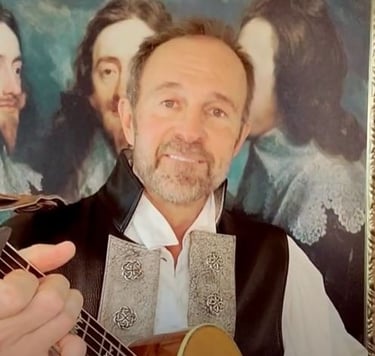

21/08/2021 - St George's Commemoration
Every year, The 1745 Association remembers the sixteen Jacobite officers executed in 1746 for their part in the Rising of 1745 and buried in St George's Gardens, Bloomsbury.
In this video of the 2021 commemoration, Stephen Lord tells their story and gives the names of the men who lie in the Gardens - 9 officers of the Manchester Regiment, 6 Scottish officers, and John Hamilton, Jacobite Governor of Carlisle. His address is followed by a pibroch played in their honour, the Lament of Donald of Laggan, played by Roddy Livingstone.
The ‘45 in 45 Minutes
Click on the Title for a direct link to these talks:
Part 1: The "Glorious Revolution" of 1688 - The truth of the matter is that the Coup of 1688 was neither glorious nor a revolution, but a squalid family squabble.
Part 2: Bonnie Prince Charlie and the Rising of 1745 - Had the Jacobites continued their advance from Derby on to London, their chances of success must be rated as at least 50:50.
Part 3: Queen Clementina's Cavinet - For all her wealth, Clementina is not a free woman. She is not free to choose her own husband. She is an asset to be traded on the market of international politics, sold to the most promising bidder in a dynastic marriage.
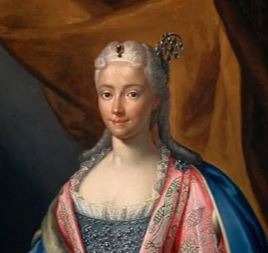

Remembering Dunkeld
The video of a commemorative event organised by The 1745 Association to help raise awareness and understanding of a cathartic moment in Scottish and British history. In August 1689, a Jacobite Army supporting the restoration of King James VII and II met a Williamite Army at Dunkeld in the Scottish Highlands. In August 2019, The 1745 Association gathered at Dunkeld to remember the events of that fateful day.
The Story of Killiecrankie Battlefield and Transport Scotland's plan to destroy its heart
This is about the proposed road works that Transport Scotland are looking to dual the A9 through the Battlefield of Killicrankie. They are proposing to duel the south side of the existing road which will destroy the most important part of the Battlefield.
The aim is to get to get them to change their plans and dual the north side of the A9 which would have much less impact on the battlefield.
The 1745 Association
Preserving Jacobite history and its significant sites.
© 2025. All rights reserved.


